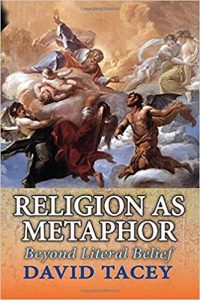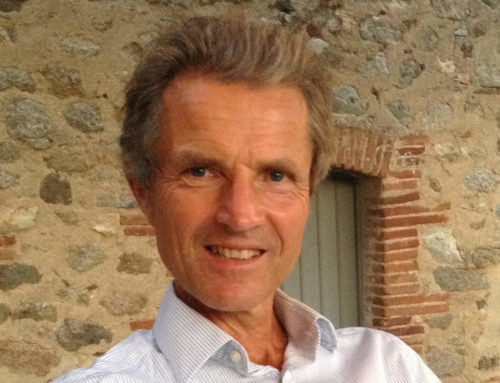Book review by David Lorimer
RELIGION AS METAPHOR
David Tacey
Transaction Publishers, 2015, 258 pp.
ISBN: 978-1-4128-5610-2
This is a book that should be widely read, but sadly the publishers are pricing it out of the reach of ordinary readers – so hopefully it will soon appear in paperback. Subtitled ‘beyond literal belief’, this searching study steers a middle course between the Scylla of uneducated belief or religious literalism and the Charybdis of educated disbelief or fundamentalist atheism. As a sympathetic scholar of Jung, David parts company with Freud and Dawkins by maintaining that religion is in fact metaphorical rather than illusory or delusory. It is a serious error to conflate belief with faith – his view is that ‘religion is not a series of dogmas to be believed, but a collection of poems to be experienced’ (p. 103) Knowledge can destroy belief, but not faith.
Both science and nearly 200 years of biblical criticism have made it increasingly problematic – even untenable – to take a literal view of the Bible, even though millions still do – some readers may recall my review of Beyond Belief in Network Review 122, where James MacDonald spelt out the history of distortions, mistranslations, forgeries and interpolations not only in the New Testament but also in the development of Jesus into an archetypal and mythical figure (c.f. the Jesus of history and the Christ of faith) . Hence David’s argument that the only credible way forward is to interpret religion methodologically and symbolically so as not to throw out the baby with the bathwater. He advocates a renewal of faith, but dissociated from belief. In a series of chapters, he discusses the status of miracles, the soul’s symbolic code, Jesus the metaphor, the myths of the virgin birth and resurrection, and the symbolic meaning of apocalypse and waking up. He agrees with Joseph Campbell when he said that every religion is true when understood metaphorically, but when metaphors are interpreted as facts, then there is trouble.
David’s position opens him up to attack from both sides of the fundamentalist divide, both literalists and the new atheists. While I am very sympathetic to his quest, I do part company with him on his interpretation of some miracles – he categorises them all as metaphorical, while I would maintain that at least the healing miracles are credible in relation to evidence through the ages up to our own time – spiritual figures like Peter Deunov and St Padre Pio have reproduced such phenomena, although I would agree with him on other matters such as feeding the 5,000 and turning water into wine. He is anxious to avoid any taint of supernaturalism, which I think also affects his interpretation of the resurrection. For me, the Pauline distinction between the natural and spiritual body makes a lot of sense in terms of modern studies of post-mortem apparitions. Some early theologians like Tertullian were keen to insist on the extreme and incredible position of the resurrection of the flesh rather than the body.
Ironically, the rise of science and its one-dimensional insistence on logos was paralleled by the continuing literalism of fundamentalists and the Protestant focus on the Word rather than tradition. Neither understood the meaning of mythos and its relation to logos, which is beautifully explained by Karen Armstrong when she says that myth was concerned with the timeless and constant, with meaning and context, directing our attention to the eternal and universal. Similarly, Mircea Eliade writes that myth is not a stage of consciousness but rather a structure in the content of consciousness, while Jung reflected that we have become rich in knowledge, but poor in wisdom. Myth is naïvely defined as falsehood rather than another layer of meaning expressed symbolically.
An important theme running through the book is transformation, the real meaning of metanoia, which fundamentalists must translate as repentance – sin (hamartia) literally means missing the mark. Jesus came to initiate a more intimate and inner relationship with God, a spiritual revolution that is also a recovery of spirit and in sympathy with gnosis. David urges the reader to wake up to interiority, the immanent Divine leading to a new self beyond the narcissism of the separate ego, a journey towards completion and wholeness rather than perfection. It is our normal state of relative somnolescence that needs to be overcome and deconstructed, as Socrates also advocated.
The demythologisation agenda of Rudolf Bultmann is not enough since beyond deconstruction we need reconstruction and Jungian remythologisation, the acquisition of symbolic literacy. Symbols are spiritually but not literally true. In an interesting exchange with the progressive theologian Don Cupitt (whom I knew in Cambridge in the late 1970s with his book The Myth of God Incarnate), David rightly pulls him up as demonstrating the perils of a purely intellectual approach to religion, leading to rationalism, reductionism, relativism, atheism and nihilism. By contrast, he contends that faith requires a hermeneutics of affirmation and a symbolic depth. New atheists like Christopher Hitchens set up a straw man by arguing that the Gospels must in some sense be literally true, which leaves no room for a subtler and deeper approach beyond sophisticated educated disbelief. We can follow pioneers like Meister Eckhart and Blake, as David suggests, and he could also have mentioned the work of Swedenborg in the 18th century, who systematically explained the symbolic meaning of what his contemporaries took literally. So while I personally would not entirely bracket off what we call the supernatural from the natural, I am persuaded by David’s overall argument that a symbolic approach is the only meaningful way forward. This book is a significant and welcome contribution to this important debate.
Buy Religion as Metaphor here.
